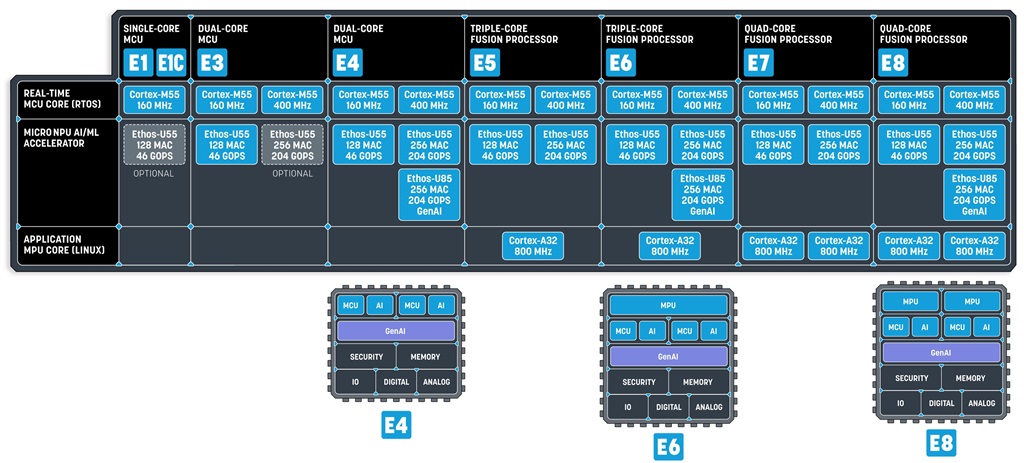The trend of integrating generative artificial intelligence (Gen AI) applications into edge AI (Edge AI) is gaining momentum. More Edge AI systems are providing intelligent applications with multi-layered user interaction, stimulating explosive growth opportunities in Edge AI. For example, at CES 2025, we saw the unveiling of new products such as AI toys, AI pets, AI robots, and AI robot dogs. Emerging applications using compact, energy-efficient smart devices coupled with AI inference and ample computing power are on the rise.
Edge AI currently demands higher performance, privacy, response speed, and efficiency. However, due to the limitations of miniaturized devices in computing power, memory capacity, and battery size, the industry is actively addressing this demanding challenge. Thanks to the rapid iteration of cutting-edge semiconductor and AI technologies, a microcontroller (MCU) semiconductor solution supporting a neural processing unit (NPU) is rapidly emerging in the market. Aiming to quickly meet AI MCU products that combine security, energy saving, and computing power, it aims to meet these requirements.
Alif Launches New Ensemble MCU Series E4, E6, and E8 Products
Alif Semiconductor, a global leader in AI MCU technology, announced the latest additions to its New Generation Ensemble MCU family on August 12, 2025. The three new models, E4, E6, and E8, are designed to handle the workloads required for generative AI inference on Edge AI devices. Targeted for battery-powered use cases, these products enable rapid execution of generative AI applications on compact devices such as wearables. They feature core capabilities for ultra-low power consumption and information security. By eliminating the need for frequent charging and degrading the user experience, Alif's New Generation Ensemble E4/E6/E8 MCU solutions establish a leading position in the Edge AI market.
In terms of product specifications, the E4, E6, and E8 products feature functional configurations ranging from dual-core, triple-core, to quad-core microprocessors. The E4 chip, for example, features two Cortex-M55 MCU cores, each paired with an Ethos-U55 NPU, and additionally there is an Ethos-U85 NPU that can be accessed by either Cortex-M55 for Generative AI tasks. This coupled with flexible built-in memory configurations, including up to 5.5MB of MRAM and a maximum of 9.75MB of SRAM, greatly facilitates the execution of diverse AI models.
The E6 chip adds a Cortex-A32 core to create a tri-core microprocessor to address applications requiring higher computing power for AI model inference. The highest-performance E8 chip utilizes a quad-core microprocessor configuration, combining the a forementioned configuration with a Cortex-A32 core to meet the demands of highly complex generative AI inference. Through this new product combination, Alif is optimistic about new business opportunities for generative AI applications in subsequent consumer electronics products and is poised to capitalize on diverse Edge AI applications and the flourishing business opportunities.
Ethos-U85 NPU is configured to run Transformer-based neural network systems with high efficiency
Alif's new Ensemble MCU is equipped with the Arm Ethos-U85 NPU, making it the industry's first MCU product to be launched with this NPU. It supports generative AI neural networks based on the Transformer architecture, providing ultra-low energy efficiency. Current customer test data shows that some AI toys capable of automatically generating and compiling story content tailored to children's age, emotions, and personalization use a small language AI model (SLM) to execute story generation scripts on Ensemble's E4 chip, consuming only 36mW of power. These AI toys also have voice control capabilities for interactive interactions with children, representing new applications that combine educational and entertainment value, creating optimistic expectations for the market for smart toys and a wider range of interactive smart devices.
Accelerated image processing achieves object detection in 2 milliseconds and image classification in under 8 milliseconds
In terms of image processing performance, the new chips currently support up to two MIPI-CSI image sensors and include a fully hardware-accelerated image signal processor (ISP) channel. Thanks to the design of a high-performance memory subsystem, high-speed video image captures up to 60 frames per second (fps) at a 2-megapixel resolution is achieved. In particular, the chips are equipped with ultra-energy-efficient and highly flexible MRAM memory, which enables AI inference speeds to be reduced to under one millisecond.
Given that generative AI is playing a vital role in optimizing intelligent robotics, it not only enhances the precision and adaptability of autonomous robots, but also the new E4/E6/E8 products in the New Generation Ensemble MCU series can enhance real-time data acquisition and analysis capabilities in applications such as health monitoring and wearable devices. This allows OEM/ODM electronic product development teams to launch a new generation of user experiences that create a good interactive experience with generative AI. This can then be expanded to include solutions in areas such as smart robots for medical care, smart healthcare or auxiliary diagnosis, smart transportation, smart toys, smart homes and smart cities, driving innovation in the next generation of AI products.
For more information, please visit Alif Semiconductor website.

Ensemble Family

